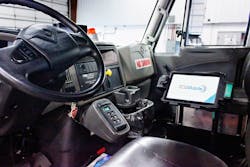The idea behind smart metering for airport fueling activities has existed in some form for decades.
In the 1990s, temperature correction capabilities and electronic ticketing were considered smart metering functions. At the turn of the century, monitoring differential pressure and utilizing wireless communication for data collection highlighted new features of smart metering systems.
And with time, the types of data that refuelers sought have evolved and grown, requiring smart metering to be redefined yet again as data from more components is being tracked and incorporated into electronic flow meters.
“When you talk about smart metering, that's really when it got deep because then we started collecting that information from all over – from different components of the refueler – and getting that pushed up to the cloud,” explains Dan Murray, president at Total Control Systems (TCS).
From recording data to measuring fuel and additives and tracking quality control processes on a refueler or at a tank farm, smart metering allows for accurate, efficient fueling operations at airports.
“Smart metering covers a lot,” Murray says.
“You’re trying to support the fleet management groups, the equipment groups – like the World Fuels, the Signatures, Avfuels, Titans. And then you’re supporting the large network FBOs. There’s a lot going on,” he continues. “Everybody has a unique take on what they want. Being able to be diverse enough to manage all the different requests that come through is a challenge.”
To better assist refuelers with their daily operations, companies like TCS collect information from an electronic flow meter, store it in the cloud and present it to customers in a way that allows a deeper understanding of all fueling activities.
“Trying to get the information from that meter to the cloud is the name of the game,” Murray says.
Focus on Flow Meters
To take advantage of smart metering, having a flow meter capable of recording data is a must.
As Murray notes, the flow meter is the custody transfer/resell device, allowing fuel distributors to record fuel deliveries to an FBO and that FBO to record fuel uplifts into aircraft.
“That meter became the focus point for all the data collection – trying to measure the differential pressure, the water content, your additive, your tank level, your temperatures and density – and putting it into one fuel record that we store in the cloud,” Murray says. “They use that statistical data to take a look at the overall operation, the efficiency of the vehicle and their fueling system, and the maintenance.
“They can do their predictive maintenance off that,” he adds. “They can read the data from the refuelers.”
An electronic flow meter on a refueling truck, coupled with an app or software, allows data to be gathered.
“You need the electronic flow computer. That's going to collect the information that we're talking about on the refueler,” Murray says. “And from there, you need a communication device to get that data to whatever end point that may be. That could be the back office accounting software. That could be in equipment maintenance software. It could be just a launchpad to collect the data and then push it on to another accounting software.
“The main thing is they got to have electronics on the vehicle,” he says noting electronic flow meters can be retrofitted to existing vehicles.
What Data is Collected, and Why
Depending on the individual operation, the most pertinent data will vary. Fueling data can be used for long-term recordkeeping, immediate point-of-sale documentation and much more.
For example, Murray says an into-plane agent is likely interested in recording flight numbers. Then the ground handling agent can record the flights that he or she is fueling, the time they started and finished the uplift, as well as the volume uplifted.
Alternatively, Murray says an FBO may be looking for the aircraft’s registration number, so a receipt for fuel can be created immediately and delivered to an operator quickly.
For a fleet company or a fuel marketer like World Fuel Services, Signature, Avfuel or Titan, smart metering helps fleet managers keep their vehicles up and running for branded FBOs.
“They’re looking for the error codes, they're looking for the fault points, so they can keep their trucks in continuous operation and not have any downtime,” Murray says.
“Everybody's got a different slice that they're paying attention to.”
The key to utilizing data is making sure the information can be consumed efficiently.
At Total Control Systems, the company’s TCS Hub allows users to configure dashboards to display whatever is most important to a specific operation.
“Is it the tank farm? You're just kind of keeping reconciliation with what the tank farm was doing for that day. Is it your mobile fueling? What's your mobile stock levels?” Murray offers as an example. “And then you got a ticketing screen. You see all the data coming through and you're verifying that that data delivery that we're recording is actually mirroring what's going into the back office accounting software. So it's a verification process.”
Report information is customizable, allowing users to generate reports for any data they need. Reports can be generated based off an aircraft’s registration number, which piece of equipment was used for refueling or based on which staff member conducted the uplift.
“Say you have a pilot. He's put an order in for 400 gallons of jet fuel with FSII (fuel system icing inhibitor),” Murray says. “That pilot should be looking at that receipt to make sure he got that 400 gallons and how much FSII went along with it. We can provide that data.
“We can tell him exactly how much additive he got, how much jet fuel he got, if he got it or if he didn't,” he continues. “You can actually have all that there and actually control the additive pumps accordingly. All that is extremely important.”
Electronic flow meters offer preset configurations to ensure accuracy and safety. Additionally, the meters can automatically calculate fuel uplifts by weight, removing that requirement from a human’s list of tasks.
“You can actually have the delivered volume, as well as the delivered weight, on the same screen and on the same delivery ticket,” Murray says, noting temperature and density correction can also be programed into the unit in addition to other safety features.
If the refueler detects readings outside of threshold limits, the smart meter can end delivery of fuel.
“That is a major safety component. If your filtration has basically deteriorated, so the flow rate increases so much, we put a limit in there. You obviously had a filter blowout, so we end the delivery,” Murray says. “If your differential pressure is too high, we end the delivery. If your additive rate has fallen out of tolerance, we end the delivery. So, we're always making sure that your fueling is on point.”
TCS also worked with Phillips 66 and the National Air Transportation Association (NATA) to create a screensaver with the Save a Life, Verify Fuel Type logo.
“The first thing the operator does when he's looking at the register, he sees that logo before he hits start,” Murray says. “It's all in an effort to try to promote more safety on the airport.”
Future Outlook
Smart metering has evolved over the last two decades, and Murray anticipates seeing more improvements, particularly streamlining how data is shared.
“You’re going to see more fluidity from the smart metering technology to the back office,” he says. “We're getting there. It's just going to be a lot more efficient in the future. You're seeing that with electronic tickets.”
Murray reiterates that smart meters should be comprehensive and flexible to meet the wide variety of needs that exist in aviation fueling.
“It’s about efficiency. How quickly can we actually deliver fuel to the customer and get a receipt in their hands,” Murray says.
“There’s lots of reasons why people use this information,” he continues. “In the future, it’s going to be about recordkeeping SAF (sustainable aviation fuel). How much fuel, what percentage of that fuel is SAF and what kind of emission credits they can earn and pass on.”
Because the fueling operators are seeking a vast range of data, Murray emphasizes the importance of adopting new technology so the needs of the industry can continue being met.
About the Author
Josh Smith
Editor
Josh Smith served as editor of Ground Support Worldwide as editor from 2016 through 2024. He oversaw production of the print magazine, created GSW's newsletters on a daily basis, and updated the latest news on AviationPros.com.

